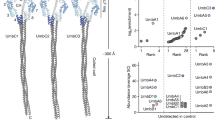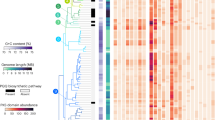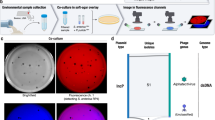Abstract
A polyphasic approach was used to determine the taxonomic position of a marine actinomycete, designated isolate CWH03T, which we previously reported to produce new linear azole-containing peptides spongiicolazolicins A and B. Strain CWH03T is mesophilic, neutrophilic, and halotolerant streptomycete that forms spiral spore chains on aerial mycelium. Comparative 16S rRNA gene sequencing showed that CWH03T was most closely related to Streptomyces tirandamycinicus HNM0039T (99.7%), Streptomyces spongiicola HNM0071T (99.4%), ‘Streptomyces marianii’ ICN19T (99.1%) and Streptomyces wuyuanensis CGMCC4.7042T (99.0%). The phylogenetic tree prepared using the 16S rRNA gene, as well as the phylogenomic tree using the genome BLAST distance phylogeny method and 81 core housekeeping genes, respectively, showed that the closest relative of strain CWH03T was S. spongiicola HNM0071T. The average nucleotide identity and digital DNA-DNA hybridization values between strains CWH03T and S. spongiicola HNM0071T were 91.46% and 44.2%, respectively, which were below the thresholds of 96% and 70% for prokaryotic conspecific assignation. The G+C content of the genomic DNA of strain CWH03T was 72.3%. Whole-cell hydrolysates of strain CWH03T contained LL-diaminopimelic acid. The predominant menaquinone was MK-9(H8) (88.3%), and the major fatty acids were iso-C16:0 (28.4%), anteiso-C15:0 (15.0%) and iso-C15:0 (12.9%). The major phospholipids were diphosphatidylglycerol, phosphatidylglycerol, phosphatidylethanolamine and an unidentified phospholipid. Based on data obtained from phenotypic, phylogenetic, genomic, and chemotaxonomic analyses, strain CWH03T represents a novel species of the genus Streptomyces, for which the proposed name is Streptomyces pacificus sp. nov. The type strain is CWH03T ( = NBRC 114659T = TBRC 15780T).
This is a preview of subscription content, access via your institution
Access options
Subscribe to this journal
Receive 12 print issues and online access
$259.00 per year
only $21.58 per issue
Buy this article
- Purchase on Springer Link
- Instant access to full article PDF
Prices may be subject to local taxes which are calculated during checkout




Similar content being viewed by others
References
Schatz A, Bugle E, Waksman SA. Streptomycin, a substance exhibiting antibiotic activity against Gram-positive and Gram-negative bacteria. Proc Soc Exp Biol Med. 1944;55:66–9.
Bérdy J. Bioactive microbial metabolites. J Antibiot. 2005;58:1–26.
Zhang J, Hassan HA, Abdelmohsen UR, Zahran EM. A glossary for chemical approaches towards unlocking the trove of metabolic treasures in actinomycetes. Molecules 2022;27:142.
Bhattarai K, Bastola R, Baral B. Antibiotic drug discovery: Challenges and perspectives in the light of emerging antibiotic resistance. Adv Genet. 2020;105:229–92.
Ramesh S, Mathivanan N. Screening of marine actinomycetes isolated from the Bay of Bengal, India for antimicrobial activity and industrial enzymes. World J Microbiol Biotechnol. 2009;25:2103–11.
Subramani R, Aalbersberg W. Marine actinomycetes: An ongoing source of novel bioactive metabolites. Microbiol Res. 2012;167:571–80.
Jose PA, Maharshi A, Jha B. Actinobacteria in natural products research: Progress and prospects. Microbiol Res. 2021;246:1–14.
Safaei N, et al. Angucycline-like aromatic polyketide from a novel Streptomyces species reveals freshwater snail Physa acuta as underexplored reservoir for antibiotic-producing actinomycetes. Antibiotics (Basel). 2020;10:22.
Iniyan AM, et al. Streptomyces marianii sp. nov., a novel marine actinomycete from southern coast of India. J Antibiot. 2021;74:59–69.
Zhao XQ, et al. Streptomyces xinghaiensis sp. nov., isolated from marine sediment. Int J Syst Evol Microbiol. 2009;59:2870–4.
Mangamuri U, Vijayalakshmi M, Ganduri VSRK, Rajulapati SB, Poda S. Extracellular L-Asparaginase from Streptomyces labedae VSM-6: Isolation, Production and Optimization of Culture Conditions Using RSM. Pharmacogn J. 2017;9:932–41.
Huang X, Zhou S, Huang D, Chen J, Zhu W. Streptomyces spongiicola sp. nov., an actinomycete derived from marine sponge. Int J Syst Evol Microbiol. 2015;66:738–43.
Li L, Wang J, Zhou YJ, Lin HW, Lu YH. (2019). Streptomyces reniochalinae sp. nov. and Streptomyces diacarni sp. nov., from marine sponges. Int J Syst Evol Microbiol. 2019;69:99–104.
Huang X, et al. Streptomyces tirandamycinicus sp. nov., a novel marine sponge-derived actinobacterium with antibacterial potential against Streptococcus agalactiae. Front Microbiol. 2019;10:1–11.
Braña AF, et al. Desertomycin G, a new antibiotic with activity against Mycobacterium tuberculosis and human breast tumor cell lines produced by Streptomyces althioticus MSM3, isolated from the Cantabrian Sea Intertidal macroalgae Ulva sp. Mar Drugs. 2019;17:114.
Zhang S, et al. Antimicrobial tunicamycin derivatives from the deep sea-derived Streptomyces xinghaiensis SCSIO S15077. Nat Prod Res. 2020;34:1499–1504.
Ishida K, et al. New dihydronaphthothiophene derivatives by the biological transformation of seriniquinone using marine-derived actinomycete Streptomyces albogriseolus OM27-12. J Antibiot. 2021;75:9–15.
Suzuki M, et al. Isolation and structure determination of new linear azole-containing peptides spongiicolazolicins A and B from Streptomyces sp. CWH03. Appl Microbiol Biotechnol. 2021;105:93–104.
Goris J, et al. DNA-DNA hybridization values and their relationship to whole- genome sequence similarities. Int J Syst Evol Microbiol. 2007;57:81–91.
Shirling EB, Gottlibe D. Methods for characterization of Streptomyces species. Int J Syst Bacteriol. 1966;16:313–40.
Tamura T, Hatano K. Phylogenetic analysis of the genus Actinoplanes and transfer of Actinoplanes minutisporangius Ruan et al. 1986 and ‘Actinoplanes aurantiacus’ to Cryptosporangium minutisporangium comb. nov. and Cryptosporangium aurantiacum sp. nov. Int J Syst Evol Microbiol. 2001;51:2119–25.
Yoon SH, et al. Introducing EzBioCloud: A taxonomically united database of 16S rRNA gene sequences and whole-genome assemblies. Int J Syst Evol Microbiol. 2017;67:1613–7.
Saitou N, Nei M. The neighbor-joining method: A new method for reconstructing phylogenetic trees. Mol Biol Evol. 1987;4:406–25.
Takahashi K, Nei M. Efficiencies of fast algorithms of phylogenetic inference under the criteria of maximum parsimony, minimum evolution, and maximum likelihood when a large number of sequences are used. Mol Biol Evol. 2000;17:1251–8.
Felsenstein J. Evolutionary trees from DNA sequences: A maximum likelihood approach. J Mol Evol. 1981;17:368–76.
Kumar S, Stecher G, Li M, Knyaz C, Tamura K. MEGA X: Molecular evolutionary genetics analysis across computing platforms. Mol Biol Evol. 2021;35:1547–9.
Felsenstein J. Confidence limits on phylogenies: An approach using the bootstrap. Evolution 1985;39:783–91.
Tanizawa Y, Fujisawa T, Arita M, Nakamura Y. DFAST: A flexible prokaryotic genome annotation pipeline for faster genome publication. Methods Mol Biol. 2019;1962:215–26.
Kim J, Na SI, Kim D, Chun J. UBCG2: Up-to-date bacterial core genes and pipeline for phylogenomic analysis. J Microbiol. 2021;59:609–15.
Meier-Kolthoff JP, Göker M. TYGS is an automated high-throughput platform for state-of-the-art genome-based taxonomy. Nat Commun. 2019;10:2182.
Yoon SH, Ha SM, Lim J, Kwon S, Chun J. A large-scale evaluation of algorithms to calculate average nucleotide identity. Antonie Van Leeuwenhoek. 2017;110:1281–6.
Meier-Kolthoff JP, Carbasse JS, Peinado-Olarte RL, Göker M. TYGS and LPSN: A database tandem for fast and reliable genome-based classification and nomenclature of prokaryotes. Nucleic Acids Res. 2022;50:D801–7.
Hasegawa T, Takizawa M, Tanida S. A rapid analysis for chemical grouping of aerobic actinomycetes. J Gen Appl Microbiol. 1983;29:319–22.
Tamura T, Ishida Y, Suzuki KI. Descriptions of Actinoplanes ianthinogenes nom. rev. and Actinoplanes octamycinicus corrig. comb. nov., nom. rev. Int J Syst Evol Microbiol. 2011;61:2916–21.
Sasser M. Identification of bacteria by gas chromatography of cellular fatty acids. MIDI Technical Note 101. Newark, DE: MIDI, Inc.; 1990.
Minnikin D, et al. An integrated procedure for the extraction of bacterial isoprenoid quinones and polar lipids. J Microbiol Methods. 1984;2:233–41.
Hamada M, et al. Luteimicrobium album sp. nov., a novel actinobacterium isolated from a lichen collected in Japan, and emended description of the genus Luteimicrobium. J Antibiot. 2012;65:427–31.
Yassin AF, Haggenei B, Budzikiewicz H, Schaal KP. Fatty acid and polar lipid composition of the genus Amycolatopsis: Application of fast atom bombardment-mass spectrometry to structure analysis of underivatized phospholipids. Int J Syst Bacteriol. 1933;43:414–20.
Hayakawa M, Nonomura H. Humic acid-vitamin agar, a new medium for the selective isolation of soil actinomycetes. J Ferment Technol. 1987;65:501–9.
Japan Color Standard Laboratory (Nihon Shikisai Kenkyusho). Guide to color standard. 1st ed. Tokyo: Japan Color Standard Co. (Nihon Shikisai Sha); 1954. p. 4–9.
Gerharbt P, et al. Manual of methods for general bacteriology. In: Robert MS, Noel RK, editors. General characterization. 1st ed. Washington, DC: American Society for Microbiology; 1981. p. 409–44.
Kiska DL, Hicks K, Pettit DJ. Identification of medically relevant Nocardia species with an abbreviated battery of tests. J Clin Microbiol. 2002;40:1346–51.
Gordon RE, Barnett DA, Handerhan JE, Pang CHN. Nocardia coeliaca, Nocardia autotrophica, and the Nocardin Strain. Int J Syst Bacteriol. 1974;24:54–63.
Chun J, Oren A, Ventosa A, Christensen H, Arahal DR, et al. Proposed minimal standards for the use of genome data for the taxonomy of prokaryotes. Int J Syst Evol Microbiol. 2018;68:461–6.
Zhang X, Zhang J, Zheng J, Xin D, Xin Y, et al. Streptomyces wuyuanensis sp. nov., an actinomycete from soil. Int J Syst Evol Microbiol. 2013;63:2945–50.
Iniyan AM, Sudarman E, Wink J, Kannan RR, Vincent SGP. Ala-geninthiocin, a new broad spectrum thiopeptide antibiotic, produced by a marine Streptomyces sp. ICN19. J Antibiot. 2019;72:99–105.
Zhou S, Xiao K, Huang D, Wu W, Xu Y, et al. Complete genome sequence of Streptomyces spongiicola HNM0071T, a marine sponge-associated actinomycete producing staurosporine and echinomycin. Mar Genom. 2019;43:61–4.
Acknowledgements
This work was supported by JSPS KAKENHI Grant Number 16K07229. We are grateful to Dr. Bernhard Schink for his support with nomenclature.
Author information
Authors and Affiliations
Corresponding author
Ethics declarations
Conflict of interest
The authors declare no competing interests.
Additional information
Publisher’s note Springer Nature remains neutral with regard to jurisdictional claims in published maps and institutional affiliations.
Supplementary information
Rights and permissions
Springer Nature or its licensor (e.g. a society or other partner) holds exclusive rights to this article under a publishing agreement with the author(s) or other rightsholder(s); author self-archiving of the accepted manuscript version of this article is solely governed by the terms of such publishing agreement and applicable law.
About this article
Cite this article
Takahashi, M., Shinohara, S., Hamada, M. et al. Streptomyces pacificus sp. nov., a novel spongiicolazolicin-producing actinomycete isolated from a coastal sediment. J Antibiot 76, 93–100 (2023). https://doi.org/10.1038/s41429-022-00589-5
Received:
Accepted:
Published:
Issue Date:
DOI: https://doi.org/10.1038/s41429-022-00589-5



